New York Transfer-on-Death (TOD) Deed
This Transfer-on-Death Deed (the "Deed") is a legal document that allows you, the owner of real property in the state of New York, to pass the property directly to a beneficiary upon your death, bypassing the probate process. By executing this Deed in accordance with the New York Estates, Powers, and Trusts Law, you retain all ownership rights to the property during your lifetime, including the right to sell or mortgage the property, and to revoke this Deed at any time.
INFORMATION OF GRANTOR (Current Owner):
- Full Name: ___________________________________
- Mailing Address: ___________________________________
- City, State, ZIP: ___________________________________
DESCRIPTION OF PROPERTY:
- Legal Description: ___________________________________
- Address: ___________________________________
- County: ___________________________________
INFORMATION OF DESIGNATED BENEFICIARY(IES):
- Full Name: ___________________________________
- Mailing Address: ___________________________________
- City, State, ZIP: ___________________________________
- Relationship to Grantor: ___________________________________
ALTERNATE BENEFICIARY(IES) (Optional):
- Full Name: ___________________________________
- Mailing Address: ___________________________________
- City, State, ZIP: ___________________________________
- Relationship to Grantor: ___________________________________
By signing this Deed, the Grantor affirms that the designation of the beneficiary(ies) does not constitute a present transfer of the interest in the real property. The transfer of interest is effective upon the death of the Grantor.
ACKNOWLEDGMENT OF GRANTOR:
State of New York
County of ________________
On this ______ day of ___________, 20____, before me, a Notary Public in and for said State, personally appeared ________________________, known to me (or satisfactorily proven) to be the person(s) whose name(s) is/are subscribed to the within instrument, and acknowledged that he/she/they executed the same for the purposes therein contained.
In witness whereof, I have hereunto set my hand and official seal.
___________________________
Signature of Notary Public
My commission expires: _______________
GRANTOR'S SIGNATURE:
___________________________
Signature of Grantor
Date: ______________________
This document is prepared as a courtesy and is not intended as legal advice. It is recommended that a legal professional be consulted to ensure compliance with all state laws and requirements specific to your situation.
